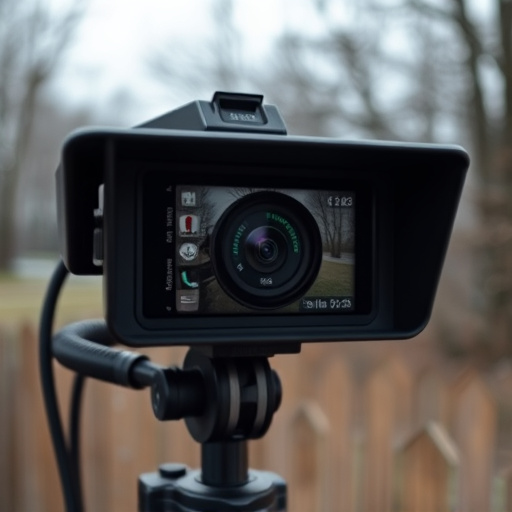Wireless Night Vision Security Cameras Indoors provide 24/7 surveillance with infrared technology, offering clear footage in low light. Strategic placement is key to overcoming signal interference and ensuring reliable transmission. Covert design makes them ideal for secret locations, enhancing privacy and security while requiring careful consideration of legal and ethical aspects, including signage and access restrictions.
Uncover hidden corners with our comprehensive guide on covert recording spot identification using wireless night vision security cameras indoors. Learn the fundamentals of these advanced devices, explore common indoor areas where they excel at going unnoticed, and discover sophisticated techniques for successful deployment. We also navigate legal considerations and ethical implications, ensuring responsible use.
- Understanding Wireless Night Vision Camera Basics
- Identifying Hidden Spots: Common Indoor Areas
- Advanced Techniques for Covert Recording
- Legal Considerations and Ethical Use of Hidden Cameras
Understanding Wireless Night Vision Camera Basics
Wireless night vision security cameras indoors have become increasingly popular for home and business security due to their advanced capabilities and ease of installation. These cameras utilize infrared (IR) technology to capture clear images in low-light conditions, effectively providing 24/7 surveillance. The basic components include a camera unit with an IR LED array, a wireless transmission module, and a receiver or mobile app for viewing footage.
Understanding how these systems work is crucial when identifying suitable placement spots. Wireless cameras use either Wi-Fi or a dedicated radio frequency (RF) network to transmit video data. Indoor environments present unique challenges, such as obstacles like walls and furniture, which can interfere with signal strength. Therefore, strategic positioning near line-of-sight areas while considering factors like angle and distance ensures optimal camera performance and reliable footage transmission.
Identifying Hidden Spots: Common Indoor Areas
Identifying hidden spots for covert recording involves exploring common indoor areas where surveillance might go unnoticed. Wireless night vision security cameras indoors are particularly useful in this regard due to their discreet design and advanced features. These devices can be seamlessly integrated into various spaces, from narrow corridors and basements to offices and bedrooms, without drawing attention.
By utilizing infrared technology and low-light sensitivity, wireless night vision security cameras capture clear images even in dimly lit conditions. They offer remote access via smartphone apps, allowing users to monitor activities in real time. Discreet placement near windows, doors, or common areas can help uncover potential issues or suspicious behavior, making them indispensable tools for home and business owners seeking covert recording solutions.
Advanced Techniques for Covert Recording
In today’s digital era, advanced techniques for covert recording have evolved significantly, offering enhanced privacy and security measures. One of the most sophisticated tools is the use of Wireless Night Vision Security Cameras Indoors. These cameras are designed to operate discreetly while providing crystal-clear visuals in low-light conditions, making them ideal for identifying hidden spots or suspicious activities within homes, offices, or any indoor environment.
The technology behind these cameras includes advanced infrared (IR) sensors that detect and convert heat signatures into visible light, allowing for clear images even in complete darkness. Additionally, motion detection capabilities trigger recording only when movement is detected, conserving storage space and battery life. This ensures that sensitive information remains secure while minimizing the risk of false positives.
Legal Considerations and Ethical Use of Hidden Cameras
The use of hidden cameras, especially wireless night vision security cameras indoors, is a double-edged sword that offers both significant benefits and legal, ethical challenges. While they serve as powerful tools for enhancing security and deterring criminal activity, their covert nature raises serious privacy concerns. It’s crucial to understand the legal framework surrounding their deployment to ensure compliance and avoid potential legal repercussions.
In many jurisdictions, the placement of hidden cameras is subject to strict regulations regarding surveillance and privacy rights. The use of wireless night vision security cameras indoors may be permissible under certain conditions, such as for business security or monitoring high-value assets, but they must not infringe upon individuals’ reasonable expectations of privacy. Ethical considerations also dictate that camera placement should be transparent, with clear signage indicating the presence of surveillance, and access to footage should be restricted to authorized personnel only. Responsible use involves a delicate balance between maintaining safety and respecting personal privacy.
The guide has equipped readers with a comprehensive understanding of covert recording techniques, from the fundamentals of wireless night vision security cameras indoors to advanced methods for identifying hidden spots. By navigating common indoor areas and exploring legal boundaries, individuals can ensure ethical use of these powerful tools. Remember that responsible implementation is key, allowing you to harness the benefits while respecting privacy.
